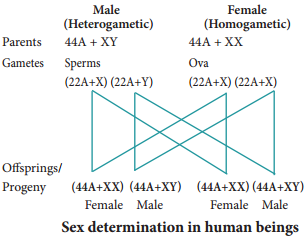Learninsta presents the core concepts of Biology with high-quality research papers and topical review articles.
Sex Determination – An Overview
Sex determination is the method by which the distinction between male and female is established in a species. Sex chromosomes determine the sex of the individual in dioecious or unisexual organisms. The chromosomes other than the sex chromosomes of an individual are called autosomes.
Sex chromosomes may be similar (homomorphic) in one sex and dissimilar (heteromorphic) in the other. Individuals having homomorphic sex chromosomes produce only one type of gametes (homogametic) whereas heteromorphic individuals produce two types of gametes (heterogametic).
Chromosomal basis of sex determination
Heterogametic Sex Determination:
In heterogametic sex determination one of the sexes produces similar gametes and the other sex produces dissimilar gametes. The sex of the offspring is determined at the time of fertilization.
Heterogametic Males
In this method of sex determination the males are heterogametic producing dissimilar gametes while females are homogametic producing similar gametes. It is of two kinds XX-XO type (e.g. Bugs, cockroaches and grasshoppers) and XX-XY type (e.g. Human beings and Drosophila).
Heterogametic Females
In this method of sex determination the females are heterogametic producing dissimilar gametes while males are homogametic producing similar gametes. To avoid confusion with the XX-XO and XX-XY types of sex determination, the alphabets ‘Z’ and ‘W’ are used here instead of X and Y respectively. Heterogametic females are of two types, ZO-ZZ type (eg. Moths, butterflies and domestic chickens) and ZW-ZZ type (eg. Gypsy moth, fihes, reptiles and birds).
Sex determination in human beings
Genes determining sex in human beings are located on two sex chromosomes, called allosomes. In mammals, sex determination is associated with chromosomal differences between the two sexes, typically XX females and XY males. 23 pairs of human chromosomes include 22 pairs of autosomes (44A) and one pair of sex chromosomes (XX or XY).
Females are homogametic producing only one type of gamete (egg), each containing one X chromosome while the males are heterogametic producing two types of sperms with X and Y chromosomes. An independently evolved XX: XY system of sex chromosomes also exist in Drosophila (Fig. 4.2).

The Y Chromosome and Male Development
Current analysis of Y chromosomes has revealed numerous genes and regions with potential genetic function; some genes with or without homologous counterparts are seen on the X. Present at both ends of the Y chromosome are the pseudoautosomal regions (PARs) that are similar with regions on the X chromosome which synapse and recombine during meiosis.
The remaining 95% of the Y chromosome is referred as the Non – combining Region of the Y (NRY). The NRY is divided equally into functional genes (euchromatic) and non functional genes (heterochromatic). Within the euchromatin regions, is a gene called Sex determining region Y (SRY). In humans, absence of Y chromosome inevitably leads to female development and this SRY gene is absent in X chromosome. The gene product of SRY is the testes determining factor (TDF) present in the adult male testis.
Dosage compensation Barr Body
In 1949, Barr and Bertram first observed a condensed body in the nerve cells of female cat which was absent in the male. This condensed body was called sex chromatin by them and was later referred as Barr body. In the XY chromosomal system of sex determination, males have only one X chromosome, whereas females have two. A question arises: how does the organism compensate for this dosage differences between the sexes? In mammals the necessary dosage compensation is accomplished by the inactivation of one of the X chromosome in females so that both males and females have only one functional X chromosome per cell.
Mary Lyon suggested that Barr bodies represented an inactive chromosome, which in females becomes tightly coiled into a heterochromatin, a condensed and visible form of chromatin (Lyon’s hypothesis). The number of Barr bodies observed in cell was one less than the number of X-Chromosome. XO females have no Barr body, whereas XXY males have one Barr body.
Haplodiploidy in Honeybees
In hymenopteran insects such as honeybees, ants and wasps a mechanism of sex determination called haplodiploidy mechanism of sex determination is common. In this system, the sex of the offspring is determined by the number of sets of chromosomes it receives.
Fertilized eggs develop into females (Queen or Worker) and unfertilized eggs develop into males (drones) by parthenogenesis. It means that the males have half the number of chromosomes (haploid) and the females have double the number (diploid), hence the name haplodiplody for this system of sex determination.
This mode of sex determination facilitates the evolution of sociality in which only one diploid female becomes a queen and lays the eggs for the colony. All other females which are diploid having developed from fertilized eggs help to raise the queen’s eggs and so contribute to the queen’s reproductive success and indirectly to their own, a phenomenon known as Kin Selection. The queen constructs their social environment by releasing a hormone that suppresses fertility of the workers.